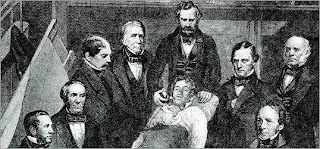
There is so much in this world that we take for granted…we have to! We can’t be experts on everything and especially when it comes to the medical world, we must trust that our doctors know what they’re talking about. However, doctors are human, like everyone else, and they do make mistakes. We must decide for ourselves how much information we want to get about any particular procedure or test.
In line with this, I thought my readers might be interested to know a little more about the history of anesthesia. Enjoy!
The date of the first operation under anesthetic, Oct. 16, 1846, ranks among the most iconic in the history of medicine. It was the moment when Boston, and indeed the United States, first emerged as a world-class center of medical innovation. The room at the heart of Massachusetts General Hospital where the operation took place has been known ever since as the Ether Dome, and the word “anesthesia” itself was coined by the Boston physician and poet Oliver Wendell Holmes to denote the strange new state of suspended consciousness that the city’s physicians had witnessed. The news from Boston swept around the world, and it was recognized within weeks as a moment that had changed medicine forever.But what precisely was invented that day? Not a chemical – the mysterious substance used by William Morton, the local dentist who performed the procedure, turned out to be simply ether, a volatile solvent that had been in common use for decades. And not the idea of anesthesia – ether, and the anesthetic gas nitrous oxide, had both been thoroughly inhaled and explored. As far back as 1525, the Renaissance physician Paracelsus had recorded that it made chickens “fall asleep, but wake up again after some time without any bad effect,” and that it “extinguishes pain” for the duration. What the great moment in the Ether Dome really marked was something less tangible but far more significant: a huge cultural shift in the idea of pain. Operating under anesthetic would transform medicine, dramatically expanding the scope of what doctors were able to accomplish. What needed to change first wasn’t the technology – that was long since established – but medicine’s readiness to use it.
How does this apply to the acceptance of music during surgery? I’ll let you draw the parallels because I think it is fairly self-evident. Music has been used in medical settings for centuries. Evidence of this can be found easily by simply Googling “history of music in medicine.” Music is one of the most ancient and powerful of medical/healing interventions. But those of us who believe this fervently must get the word out to our doctors and have proof in hand. My blogs and my websites are filled with the facts and the documentation you need. If you want more, just email me through the blog or through my website, www.HealingMusicEnterprises.com.

Leave A Comment